NEOSSat Science Guest Observation (GO) Program Cycle 1
Announcement of Opportunity
Cycle 1 period: to
Publication date:
Application deadline:
| Name of project lead | Institution | Title |
|---|---|---|
| Étienne Artigau | Université de Montréal | Photometric Monitoring of Nearby M dwarfs: Disentangling Planets from Activity |
| David Balam | National Research Council Canada | Astrometric Follow-up of NEOCP Asteroids and Comets |
| Emily Deibert | University of Toronto | Constraining the Ephemerides of a Newly-Discovered Young Planetary System |
| Chris Fox | University of Western Ontario | Follow up Transit Observations of Confirmed TESS Exoplanet TOI-123b |
| Brett Gladman | University of British Columbia | Fine time-scale monitoring of the first interstellar comet C/2019 Q4 |
| Chris Mann | Université de Montréal | Long-duration Exoplanet Transits |
| Jason Rowe | Bishop's University | NEOSSat Observations of Transiting Exoplanets (NOTES) Survey |
| Paul Wiegert | University of Western Ontario | Probing Activity on Near-Sun Asteroids Near Perihelion |
Table of contents
1. Scope of program
1.1 Overview

Figure 1 Depiction of NEOSSat micro-satellite in space. (Credit: Canadian Space Agency)
The Canadian Space Agency (CSA) solicits proposals for the acquisition and analysis of new scientific data from the NEOSSat (Near-Earth Object Surveillance Satellite) space telescope. Unaffected by day/night and weather conditions, NEOSSat is able to perform space-based imaging including conducting photometric studies with precision sufficient to perform asteroseismology studies and other variability analyses of stars and exoplanet systems. NEOSSat has already demonstrated imaging and photometry of certain exoplanet transits (see example in Appendix A1). NEOSSat is well-suited for the study of near-Earth asteroids or comets as it provides near-Sun observing capabilities and can provide direct parallax measurements of nearby objects due to its orbit around Earth. This is demonstrated in examples shown in Appendix A2, and Ref 4.c. Astrometric observations have been submitted to the Minor Planet Center (NEOSSat's observatory code is C53).
The intent of this AO is to offer observation time on NEOSSat to the scientific community on a competitive basis. CSA is not planning to issue grants as part of this announcement of opportunity (AO). Successful applicants will retrieve requested data on the CSA open data portal. There will be no proprietary period applied to the acquired datasets.
1.2 Responding to this AO
Please use the request form in Appendix B to detail your planned use of this space telescope. The form or any questions on the AO are to be sent to this email address: neossatscience@asc-csa.gc.ca.
Please note that Earth observations or imaging satellites or space debris are not eligible.
2. The NEOSSat mission
2.1 Mission overview
The Canadian NEOSSat micro-satellite orbits in a sun-synchronous orbit at 800 km altitude over the terminator of the Earth with a 100 min period (15 orbits per day). NEOSSat, with heritage from the MOST space telescope, features: onboard star catalog enabling rapid all-sky target acquisition; an extended baffle for low solar elongations observations; accurate tracking of moving objects; and a shutter enabling dark images.
NEOSSat has a single instrument, an optical 15-cm telescope with two 1024 × 1024 frame-transfer CCD detectors (Figure 2) and no filters. One CCD is dedicated for fine guidance (star tracker), while the other imager is used for the science. The instrument specifications are provided in Table 1.
| Telescope | 15 cm diameter, F/6 Rumak-Maksutov with field flattening lenses |
|---|---|
| Imager | CCD back illuminated AIMO device E2V 47-20, 1024×1024 pixels |
| Spectral range | 350 – 1050 nm (there is no photometric filter) |
| System QE peak | 0.78 @ 600nm |
| Science FOV | 0.85 x 0.85 deg (subrasters possible to increase cadence) |
| Pixel size | 13 x 13 μm |
| Pixel scale | 3 arcsec/pixel |
| PSF | Approx. 2 pixels FWHM |
| Limiting magnitude | V~19.5 (stacking or 100 sec exposure, after image post-processing) |
| Baffle | 90 cm long, to reduce stray light from both sun and Earthshine. |
| Target nominal constraints |
|
| Shutter | Between the two field lenses, used for safety and dark image calibration |
| Pointing knowledge | 1.2 arcmin (2 sigma) |
| Stability | 0.5 – 1 arcsec for 100 second exposure (after settling) |
| Min max exposures | 0.1 to 100 sec (longer possible) |
| Raster size | 256, 512, 1024 pixels (square) configurable based on science needs |
| Imaging cadence |
|
| Photometric precision | Better than 1 mmag demonstrated, but depends on SNR |
| Astrometric precision | Centroid to sub-pixel, demonstrated by stacking multiple images |
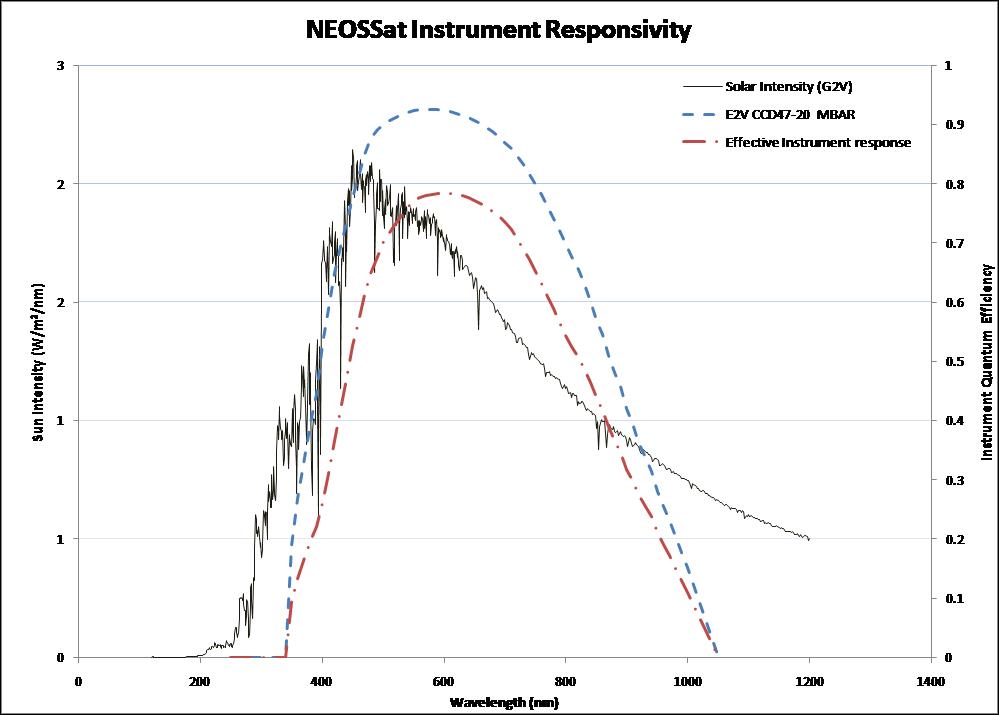
Figure 2 NEOSSat optical efficiency. This figure illustrates the relative spectral response of the CCD (quantum efficiency) superimposed on the solar spectrum and net instrument efficiency. (Credit: Canadia Space Agency)
2.2 Operations
NEOSSat operations are conducted by the CSA. The Satellite Operations team schedules observations, directs the satellite, collects the data, and monitors the health of the spacecraft and its payload. Data is downlinked typically four times daily and archived at the CSA headquarters (Saint-Hubert, Quebec). Astronomy images (in the FITS format, as detailed in Ref 4.d) are automatically distributed to CSA's Open Data portal, as discussed in Section 2.5.
2.3 Orbit and continuous viewing zone
NEOSSat's polar Sun-synchronous orbit over the terminator of the Earth results in a nominal Continuous Viewing Zone (CVZ). The CVZ is illustrated in Figure 3. The telescope can point to a target in the CVZ from any point in the orbit. There are some restrictions on the spacecraft pointing, including roll angle, due to operational constraints and spacecraft thermal constraints, which place some additional limits on CVZ access or continuity.
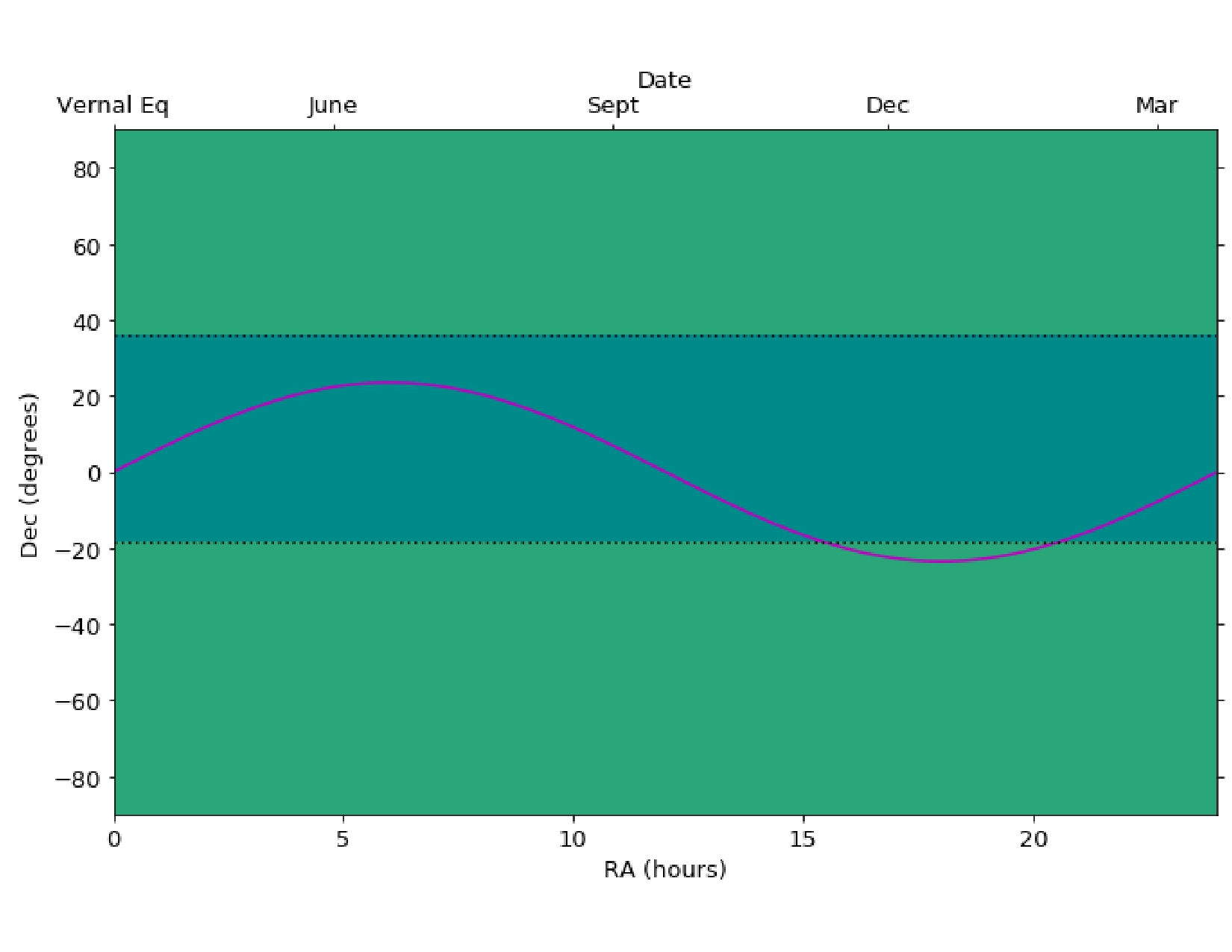
Figure 3 CVZ in dark green illustrates where the telescope can point at any time in the orbit, function of date. The telescope can point towards the sun respecting a minimum 45 deg. elongation. The scale on the right is the total target time. (Credits: Jason Rowe, Bishop's University)
Observation fields outside the CVZ can be observed by NEOSSat, but without continual coverage during a given satellite orbit. It is possible to share each NEOSSat orbit with several target fields depending on the time-sampling requirements set by the science.
The spacecraft faces an annual orbital "eclipse season" during which the satellite is in the Earth's shadow for up to fifteen minutes every orbit and hence is subject to larger-than-normal thermal changes per orbit. This occurs from late November to early February each year.
While NEOSSat can image from anywhere in its orbit, imaging done in the South Atlantic Anomaly (SAA) is subject to CCD noise due to charged particle bombardment (Figure 4). Depending on the scientific objectives, imaging is often avoided while crossing the SAA.
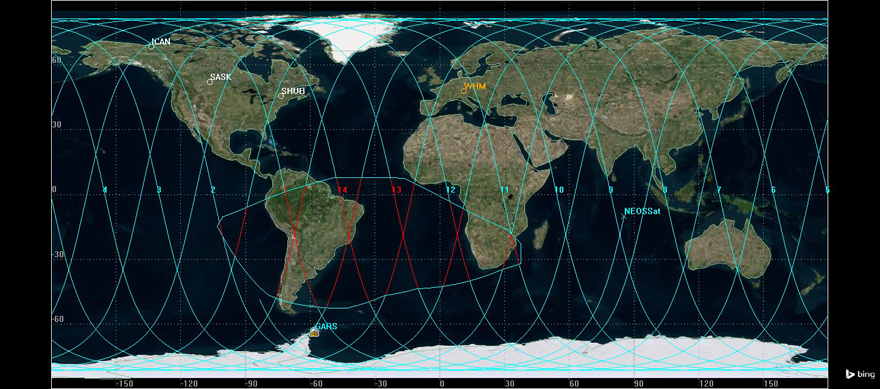
Figure 4 SAA affects portions of 11 of 14 daily orbits, either on the ascending or descending node. (Credit: Canadian Space Agency)
2.4 Instrument focal plane and exposure times
NEOSSat is equipped with two identical CCDs – one dedicated to science imaging and one as a star tracker.
Although the structure and optics were designed to be athermal, some defocus is still apparent over certain temperature ranges. There is no active temperature control system for the instrument. Depending on the scientific goals, satellite pointing strategies may be employed to manage instrument temperatures and optimize focus.
There is a shutter on the CCD camera which can be commanded to generate darks for calibration. Requirements for darks should be provided by the user and may be scheduled during certain satellite operations.
Exposure times are accurately controlled by rapid frame transfer CCD. Achievable imaging cadence depends on the exposure length and number of pixels being transferred, which can be controlled based on user-selected raster size and binning. Simultaneous readout and exposure is also supported when exposure length exceeds the readout/transfer time, which can increase the image cadence.
The spacecraft typically achieves pointing stability of about 1 arcsec RMS, so most of the image wander is around 1/3 pixel in the focal plane. Such pointing stability is achieved after a certain settling time. Imaging done before settling time may demonstrate jitter, but for short exposures this may be inconsequential.
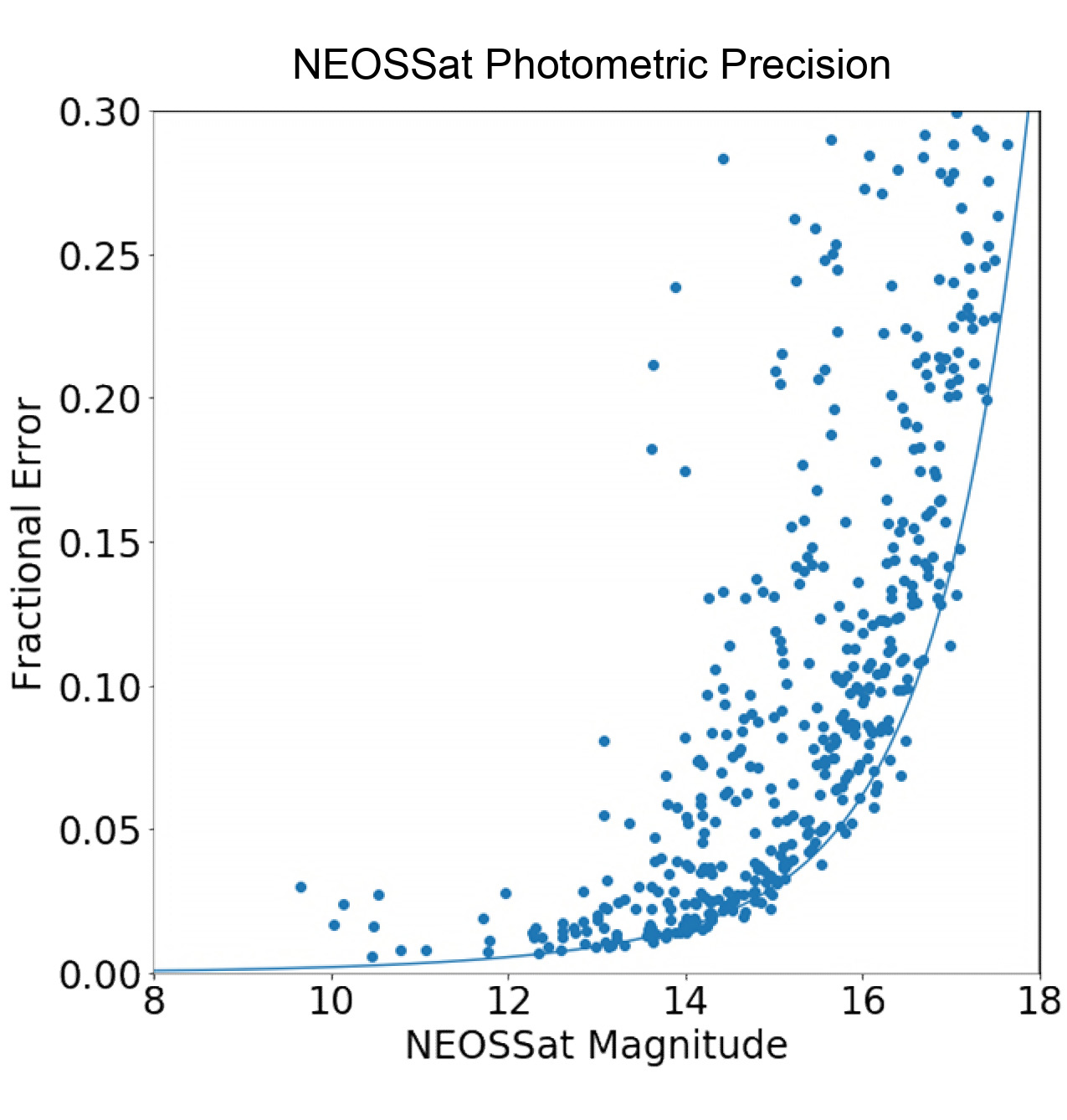
Figure 5 NEOSSat photometric error as a function of magnitude based on a star field near star Kepler K1625 (mag 14). This figure illustrates that the photometric precision is below 0.05 for stars brighter than magnitude 14 and the fractional errors increase exponentially for fainter stars. (Credits: Jason Rowe, Bishop's University)
The telescope has a baffle (Figure 1) limiting the amount of stray light due to bright objects such as the Sun, the Earth's limb or the Moon. The roll angle of the spacecraft is selected to block stray light. The performance of the baffle allows observations down to 45 degrees of solar elongation.
2.5 Data processing and archiving
NEOSSat science data (raw data - level 0) is downloaded, processed, and archived at CSA in FITS format. The raw astronomy images are copied automatically to CSA's Open Data archive, accessible from:
- FTP: Direct link to NEOSSat astronomy images on CSA FTP site.
- Government of Canada's Open Government portal: Access point from Open Government webpage.
Investigators from selected observer programs are expected to pick up their data via the Open Data portal. There is no proprietary period following image reception and the data is visible publically.
In general, NEOSSat observers are responsible for their own data processing, including noise removal and other corrections. Some NEOSSat image processing software is publically available as open source at: GitHub.
CSA is planning to introduce some of the open source image reduction tools into its automation pipeline in order to make processed data available to all users.
3. The observer program
Given that the spacecraft is time-shared with Defence Research and Development Canada (DRDC), with required spacecraft maintenance, approximately 2200 hours of observation is expected to be available per year for astronomical imaging on average.
3.1 Observing time allocation
With the CSA / DRDC joint program observing time allocation will have to be shared and prioritized. DRDC and astronomical targets of opportunity (ToO) will be considered any time and prioritized. In routine scenarios, it is expected that astronomy tasking will be interspersed with DRDC tasking. Depending on the scientific observation strategy, a few continuous days in a given week could be available for astronomy, if needed.
3.2 General observing constraints
For Cycle 1, proposals are expected for observations within the period specified, with likelihood of producing some results in that period. New proposals can be submitted in subsequent cycles to follow up on findings from prior cycles.
3.3 Proposal requirements
3.3.1 Who may propose
The intent of this program is to enhance Canadian scientific development. Therefore, only Principal Investigators (PIs) affiliated with Canadian institutions are eligible to propose for NEOSSat guest investigations through CSA. The requirement of affiliation with a Canadian institution does not extend to Co-Investigators (Co-I).
3.3.2 Target specification
All proposals are required to include a target table to specify desired observing modes and other required parameters as specified in the request form (Appendix B). CSA will review the feasibility of observing the targets considering NEOSSat constraints, such as schedule, limiting magnitudes, duration, availability of star tracking stars in the field, etc.
3.3.3 Submission of proposals
Prospective proposers to the NEOSSat GO program must adhere to the following procedures for proposal submission, as indicated in the request form:
- Proposals should include a description of the scientific objectives, a demonstration of the feasibility of the proposed observations, and how the proposal will utilize the unique capabilities of NEOSSat to carry out the investigation.
- The scientific justification should not exceed 4 pages. Tables and figures are not counted in the page limit. It can be submitted as an attachment.
- Submit the completed proposal through the email address in the AO (Section 1.2). Hard-copy submissions are not requested.
- All electronic proposal materials must be sent by 23:59 Eastern time (EDT) on the due date for this program given on the first page of the AO.
3.3.4 Evaluation and selection of proposals
Proposals submitted to CSA in response to this solicitation will be evaluated with respect to these criteria which are intrinsic merit, relevance, and feasibility:
- Science merit, justification of the investigation and potential impact to the science field.
- The suitability of using the NEOSSat observatory for the proposed investigation;
- The degree to which the investigation uses NEOSSat's unique capabilities;
- The feasibility of the proposed investigation, considering NEOSSat's observational constraints; and
- The commitment of the PI to undertake the analyses and publish results.
A CSA review panel, including expert members of the community if required, will review proposals according to the above evaluation criteria.
3.3.5 Notifications
Email acknowledgements will be sent when applications are received. The PI will be notified regarding the success of their application within 3 weeks after the closing date of the AO. PIs of successful proposals will be provided further information regarding their observation runs and data availability and distribution.
4. References
- NEOSSat CSA webpage
- MOST CSA webpage
- Conference Proceedings: Abbasi, V., Thorsteinson, S., Balam, D., Rowe, J., Laurin, D., Scott, L. and Doyon, M., (). The NEOSSat Experience: 5 Years In The Life Of Canada's Space Surveillance Telescope - 1st ESA NEO and Debris Detection Conference ()
- NEOSSat FITS User's Guide to FITS V2.08
- NEOSSat Open Government portal
- CSA's Open Data portal
5. Frequently Asked Questions (FAQ)
Applicants can obtain clarification on the AO, if necessary, before submitting a request for time. For any questions related to the AO, please use the email address in Section 1.2. Questions and answers will be posted on this webpage below. (Questions received might be rephrased and will be posted anonymously.)
Question 1: Can a PI from a government organization be eligible to apply?
Answer 1: Yes. See also FAQ #3.
Question 2: Does a PI have to be a professor or academic staff?
Answer 2: The application can be submitted by a professor, a post-doc, a graduate student, or a researcher from a Canadian institution. The applicant must demonstrate a commitment to conduct the research.
Question 3: What are the eligible "canadian institutions"?
Answer 3: A Canadian institution can be a university or post-secondary institution, a government department, ministry, or agency, a federal or provincial research institute or lab. Companies and non-government organizations with research interests are also eligible.
Question 4: Will there by future cycles of the AO?
Answer 4: Depending on the level of interest in the program, there is a plan to issue additional cycles near the completion of cycle 1. Future cycles will likely be longer and some adjustments may be made to the AO depending on the responses received for Cycle 1.
Question 5: Are observations of newly discovered objects that need confirmation eligible?
Answer 5: Yes. If a PI expects to observe new targets or events, aka "Targets of Opportunities" (ToO), during Cycle 1, we encourage a proposal, before the application deadline, that describes the anticipated ToO. An "anticipated ToO" proposal must describe the types of targets and observation modes as well as the possible number of occurrences; it must also address the criteria described in Section 3.3.4. If the "anticipated ToO" proposal is accepted, then follow-up arrangements will be made between the PI and the NEOSSat operations team for scheduling specific imaging task requests, when required. A best effort will be made to execute the observations, which may depend on imaging feasibility and schedule conflicts. Scheduling challenges may result from the short delay between the request and the observation, established priorities with other scheduled observations and satellite availability.
Question 6: Is there an exposure time calculator available for determining the best exposure time to specify for observations knowing the target star's brightness?
Answer 6: We do not have an exposure time calculator at this time. However, the following example may allow users to estimate the required exposure to achieve good SNR. For WASP-33 (V=8.3, A-type star), a 1-second exposure generates about 200,000 ADU inside a 4-pixel radius photometric aperture (gain=1.1 e/ADU). Furthermore, to estimate SNR, with shot noise, these approximate values can be used: read noise 8 e/pix, dark-current 0.2 e/pix/s and background 1 e/pix/s.
Question 7: Is it possible to observe very near-Sun targets during eclipse season? If an orbital eclipse of NEOSSat lasts up to 15 minutes, what are the delays to acquire the target and the time actually available for imaging?
Answer 7: A 2-minute minimum acquisition time is typically allocated after eclipse begins, and the rest of the time should be available for imaging the target. Operationally it is a good strategy to aim the telescope near the target in advance to minimize the acquisition overhead. If slews are timed properly, the satellite can arrive at the target just after it enters eclipse. Normally there is a 2-minute settle time to achieve fine pointing, but can be less if the prior slew is not large. For large slews, we use a slew rate of 1 deg/s.
Appendix A.1: Photometry example

Figure A.1 Photometry of WASP-33 by NEOSSat (blue points); comparison star (pink). Expected, not fitted, signal (red). The photometry is non-differential. (Credits: Jason Rowe, Bishop's University)
Appendix A.2: Astrometry examples

Figure A.2. Near-Earth asteroid 2017-VR12 (boxed) seen on UT at a distance of 0.010 AU and projected on ecliptic J2000 coordinate frame. Streaks are geostationary satellites. NEOSSat tracked 2017-VR12 closely at its Earth fly-by. (Credits: David D. Balam, Dominion Astrophysical Observatory / National Research Council of Canada)
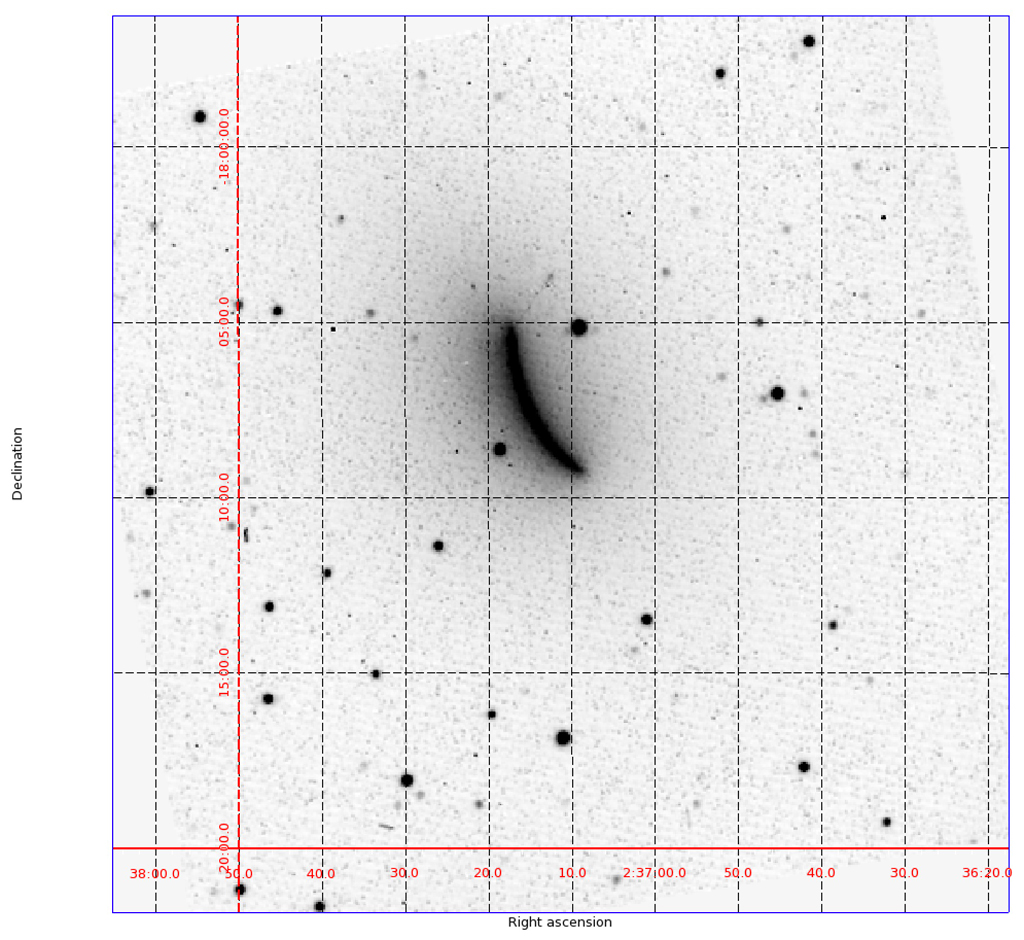
Figure A.3 The effect of parallax upon a stack of 70 images, obtained through 1/3 of the orbital period of NEOSSat. The object is Periodic Comet Wirtanen (46P) as seen on UT when the comet was 0.116 AU from the Earth. The geocentric motion vector was 261 arcseconds per hour at position angle 26.5⁰. (Credits: David D. Balam, Dominion Astrophysical Observatory / National Research Council of Canada)
Appendix B: AO request form for observation time
Responding to this AO requires completing as much as possible the form provided. The completed forms will be shared only with the CSA and the review committee. In the subject line of your email, please indicate "NEOSSat AO cycle 1" and optionally add your subtopic if pertinent such as the title of your proposal as well as adding the PI name to the PDF filename submitted.